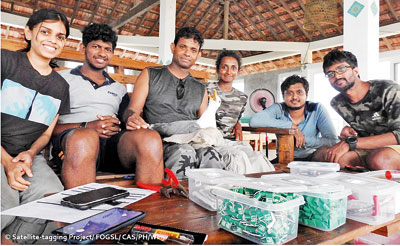News
Satellite-tracked gull reveals migratory secrets

This Heuglin’s Gull has become the first migratory bird to Sri Lanka tracked with GPS to have completed a full migration cycle. It is also the first known bird to have flown to the European Arctic from Sri Lanka.
A migratory gull’s return to Sri Lanka from northern Russia has been charted in a milestone joint project in which researchers used a global positioning system transponder fixed to the bird.
The team tracked a Heuglin’s Gull which flew to the edge of the Arctic in northern Russia from Mannar. It was tagged on April 4 this year, but had flown from Sri Lanka after 20 days. The gull they named ‘Menike’, had flown a total of 19,360 kilometres.
It flew 7,880km over 35 days to reach its breeding grounds in Yamal Peninsula in northern Russia in the Arctic region and began the return journey in late August. The bird made several stopovers over 91 days and arrived in Mannar on November 4 — six months and nine days after leaving Sri Lanka.
“With her safe arrival, ‘Menike’ becomes our first tagged bird to complete a full migration cycle and also the first known bird to travel to the European arctic from Sri Lanka,” says Prof. Sampath Senevirathne and Gayomini Panagoda, who led the team.
This study is a joint project by the Field Ornithology Group of Sri Lanka (FOGSL) of the University of Colombo and the Research Center for Eco-Environmental Sciences of the Chinese Academy of Sciences.
Mannar was chosen because this is where many migratory birds first enter Sri Lanka.
The team had received 35 GPS tags which they also fixed on other migratory birds.
The Heuglin’s Gull is a large white-headed bird found only in the north-western and northern coastal regions of Sri Lanka during the migratory season. It is a member of Lesser Back-backed Gull (Larus fuscus) complex, which consists of five similar looking gulls.
Prof Seneviratne said the migration and breeding destinations of the Larus fuscus Gulls spending winter in South Asia are not well-understood, “so we specially want to tag a bird also with intention to study the boundaries of the ‘Central Asia Flyway’, where birds used to migrate to Sri Lanka’’.

The team tags the Heuglin's Gull in Mannar on April 4 this year. The bird flew away 20 days later and returned in November.
The team also tagged a second Heuglin’s gull named ‘Megha’ which flew away on April 4. It was the first to reach northern Russia by mid-May, says Gayomini Panagoda who is working on a doctoral project.
“Though it reached its breeding grounds early, ‘Megha’ was a bit late to initiate his southward journey, leaving the Arctic only in early October. ‘Megha’ is now close to Sri Lanka, and we expect it to reach us in a few days,” Ms Panagoda told the Sunday Times.
A Brown-headed Gull they tagged had crossed the Himalayas in May this year. It was only the third bird to have crossed this extreme height.
The FOGSL together with the Department of Wildlife Conservation (DWC) initiated Sri Lanka’s National Bird Ringing Programme centered in Bundala in 2004 under the guidance of Prof. Sarath Kotagama.
“GPS-tracking helps to understand the pathways of the birds and can lead to solving many mysteries of bird migration,” says Prof. Kotagama.
Prof. Seneviratne says the Wetland International, DWC and Sri Lanka Navy and the local sponsors Palmyrah House and the Vayu Resort in Mannar too should get credit for the project.
The best way to say that you found the home of your dreams is by finding it on Hitad.lk. We have listings for apartments for sale or rent in Sri Lanka, no matter what locale you're looking for! Whether you live in Colombo, Galle, Kandy, Matara, Jaffna and more - we've got them all!

